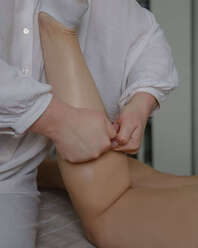Dealing with Calf muscle strains
The calf muscles, gastrocnemius and the deeper soleus run down the back of the leg between the knee and ankle. A big percentage of our forward momentum in walking and running is generated by these muscles, and we often see injuries arising from sports involving running, acceleration or sudden changes in direction such as football, soccer, hockey and basketball, just to name a few. Injuries may also occur through progressive wear and tear, with some strains then occurring simply through walking.
Symptoms
- A sudden sharp pain or “pulling” at the back of the lower leg during exercise;
- It may feel like you have been “hit” or “kicked” in the back of the leg, or perhaps heard a “pop”;
- Stretching or contracting the muscle will be painful;
- Difficulty walking or trying to stand on your toes;
- Swelling and bruising may be present;
- If a rupture is present, there may be a palpable gap or “dent” in the muscle belly.
Severity of a Calf strain
Grade 1
* Overstretching or micro-tearing of muscle fibres;
* Mild discomfort and minimal disability;
* 2 to 3 week average recovery.
Grade 2
* Partial tearing of muscle fibres;
* Moderate to severe discomfort with walking, limited ability to jump or run;
* Probable swelling and bruising;
* 5 to 8 week recovery with professional assistance.
Grade 3
* Complete tearing of muscle fibres;
* Often unable to walk unaided;
* Significant swelling and bruising and muscle spasm;
* 3 to 4 month recovery with professional assistance and possible surgery.
Physiotherapy treatment and Rehabilitation
Following the vital acute management of RICE as for other soft tissue injuries, physiotherapy treatment will depend on the severity of the calf strain. Our success rate depends on early intervention and the subsequent compliance of the client. Treatment methods may include…
- Local ultrasound and electrotherapy in the early stages to reduce swelling and stimulate healing;
- Hands on therapy such as massage, myofascial release and dry needling to reduce adhesions;
- Stretching and Strengthening of the calf itself (once pain subsides) as well as the rest of the lower limb to restore full pain free range of motion and strength to prevent re-injury;
- Core stability training and correction of any predisposing biomechanical issues are highly recommended;
- If the client is returning to sport, then a specific speed, agility and power program is implemented to ensure the best possible recovery and successful return to their pre-injury state.
I hope this summary will help you or someone you know. As always, we are here at The Physio Nook to help out with any musculoskeletal disorders you may have, calves or otherwise! Feel free to call us, email, or drop in for a great service.
Paul Woodward
Principal Physiotherapist
The Physio Nook.
- A sudden sharp pain or “pulling” at the back of the lower leg during exercise;
- It may feel like you have been “hit” or “kicked” in the back of the leg, or perhaps heard a “pop”;
- Stretching or contracting the muscle will be painful;
- Difficulty walking or trying to stand on your toes;
- Swelling and bruising may be present;
- If a rupture is present, there may be a palpable gap or “dent” in the muscle belly.
Severity of a Calf strain
Grade 1
* Overstretching or micro-tearing of muscle fibres;
* Mild discomfort and minimal disability;
* 2 to 3 week average recovery.
Grade 2
* Partial tearing of muscle fibres;
* Moderate to severe discomfort with walking, limited ability to jump or run;
* Probable swelling and bruising;
* 5 to 8 week recovery with professional assistance.
Grade 3
* Complete tearing of muscle fibres;
* Often unable to walk unaided;
* Significant swelling and bruising and muscle spasm;
* 3 to 4 month recovery with professional assistance and possible surgery.
Physiotherapy treatment and Rehabilitation
Following the vital acute management of RICE as for other soft tissue injuries, physiotherapy treatment will depend on the severity of the calf strain. Our success rate depends on early intervention and the subsequent compliance of the client. Treatment methods may include…
- Local ultrasound and electrotherapy in the early stages to reduce swelling and stimulate healing;
- Hands on therapy such as massage, myofascial release and dry needling to reduce adhesions;
- Stretching and Strengthening of the calf itself (once pain subsides) as well as the rest of the lower limb to restore full pain free range of motion and strength to prevent re-injury;
- Core stability training and correction of any predisposing biomechanical issues are highly recommended;
- If the client is returning to sport, then a specific speed, agility and power program is implemented to ensure the best possible recovery and successful return to their pre-injury state.
I hope this summary will help you or someone you know. As always, we are here at The Physio Nook to help out with any musculoskeletal disorders you may have, calves or otherwise! Feel free to call us, email, or drop in for a great service.
Paul Woodward
Principal Physiotherapist
The Physio Nook.


